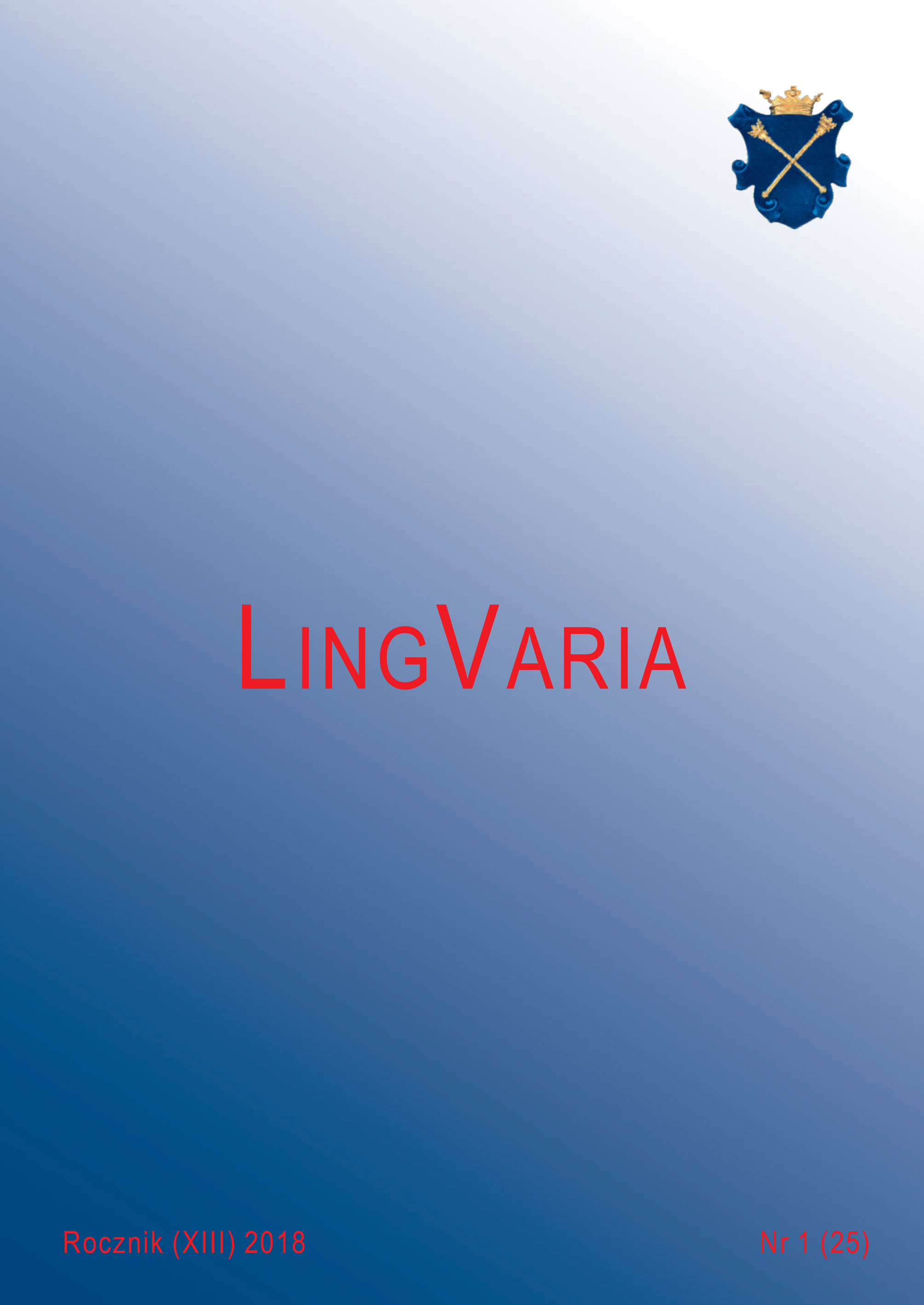Ruch, gest, gestykulacja w tekstach specjalistycznych i niespecjalistycznych
DOI:
https://doi.org/10.12797/LV.13.2017.25.19Słowa kluczowe:
gest, ruch, frazeologia, komunikacja niewerbalnaAbstrakt
Movement, Gesture, and Gesticulation in Specialist and Non-Specialist Texts
The paper presents a comparative study between expressions of the general language and specialist terms with a similar scope. All the analysed expressions of the general language, i.e. mostly units and constructions with the morphemes -ruch-, -gest-, pokaz-, and -mig-, describe in contemporary Polish motional actions of humans. As shown by contradiction tests, some of them are in addition limited to only relaying communicatively significant hand movements, revealing the existing linguistic opposition between movement and gesture, cf. -ruch- vs -gest-. An analogous contrast can also be found in the specialist language, cf. e.g. McNeill (1992) or Poggi (2007), where however gesture is used as an umbrella term for all expressive movements, cf. e.g. Kendon (2004), Lynn (2011, 2014). Furthermore, Kendon’s 1980 distinction between gesture and gesticulation understood as expressive hand movements accompanying speech, is considered to be a novel finding. It is however not taken into account that this opposition has been known to the general language for at least several hundred years and may well have been the (unwitting) inspiration for Kendon. This fact emphasizes the usefulness of research into communicative phenomena in the context of analyses of the general (meta)language.
Pobrania
Bibliografia
Antas J., 2013, Semantyczność ciała. Gesty jako znaki myślenia, Łódź.
Bäuml B.J., Bäuml F.H., 1997, Dictionary of Worldwide Gestures, Lanham.
Biber D., Conrad S., Reppen R., 1998, Corpus Linguistics. Investigating Language Structure and Use, Cambridge.
Bublitz W., Hübler A. (red.), 2007, Metapragmatics in Use, Amsterdam.
Caffi C., 1994, Metapragmatics, [w:] R.E. Asher (red.), The Encyclopedia of Language and Linguistics, Oxford, s. 2461–2466.
Culpeper J., Haugh M., 2014, Metapragmatics, [w:] iidem, Pragmatics and the English Language, Basingstoke, s. 235–263.
Dobaczewski A., 2008, Tzw. polska szkoła semantyczna a założenia strukturalizmu, czyli Ferdinand de Saussure redivivus, [w:] J. Dębowski, A. Kiklewicz (red.), Teoria i metodologia współczesnych nauk o języku, „Język poza Granicami Języka”, Olsztyn, s. 443–452.
Efron D., 1941, Gesture and Environment. A Tentative Study of Some of the Spatio-Temporal and „Linguistic” Aspects of the Gestural Behavior of Eastern Jews and Southern Italians in New York City, New York.
Ekman P., Friesen W., 1969, The Repertoire of Nonverbal Behavior: Categories, Origins, Usage and Coding, „Semiotica” 1, nr 1, s. 49–98, [on-line:] https://doi.org/10.1515/semi.1969.1.1.49.
Ekman P., Friesen W., 1972, Hand Movements, „Journal of Communication” 22, nr 4, s. 353–374, [on-line:] https://doi.org/10.1111/j.1460-2466.1972.tb00163.x.
EOLD: English Oxford Living Dictionaries, [on-line:] https://en.oxforddictionaries.com/.
ESJP: A. Bańkowski, Etymologiczny słownik języka polskiego, Warszawa 2000.
Goldin-Meadow S., 2003, Hearing Gesture. How Our Hands Help Us Think, Cambridge – London.
Heliasz C., 2015, On Representations of Communication in the English and the Polish Language, „Issledovanij po slovjanskoj lingvistike” t. 20, nr 1, s. 77–94.
Heliasz-Nowosielska C., 2016a, Granice interpretacji lingwistycznej w badaniach nad
komunikacją niewerbalną, „Biuletyn Polskiego Towarzystwa Językoznawczego” LXII, s. 97–109.
Heliasz-Nowosielska C., 2016b, Opis użycia słów i gestów w komunikacji – perspektywa użytkownika języka a perspektywa badacza specjalisty, „Linguistica Copernicana” 13, s. 251–271, [on-line:] http://dx.doi.org/10.12775/LinCop.2016.012.
Heliasz-Nowosielska C., 2016c, What Does to Communicate Mean? Natural Language vs Linguistic Terminology, [w:] E. Guitiérrez Rubio, E. Kislova, E. Kubicka (red.), Beiträge zum 19. Arbeitstreffen der Europäischen Slavistischen Linguistik (Polyslav): 14.-16. September 2015, Warschau, „Die Welt der Slaven”, t. 60, Wiesbaden, s. 91–100.
ISJP: M. Bańko (red.), Inny słownik języka polskiego, Warszawa 2000.
Jarząbek K., 1994, Gestykulacja i mimika. Słownik, Katowice.
Jarząbek K., 2016, Słownik mowy ciała Polaków, Katowice.
Karpiński M., 2006, Struktura i intonacja polskiego dialogu zadaniowego, Poznań.
Kendon A., 1980, Gesticulation and Speech. Two Aspects of the Process of Utterance, [w:] M.R. Key (red.), Relationship of Verbal and Nonverbal Communication, The Hague – Paris – New York, s. 207–227.
Kendon A., 1988, How Gestures Become Like Words, [w:] F. Poyatos (red.), Cross-Cultural Perspectives in Nonverbal Communication, New York, s. 131–141.
Kendon A., 2004, Gesture. Visible Action as Utterance, Cambridge.
Lynn U., 2011, Keep in Touch – A Dictionary of Contemporary Physical Contact Gestures in the Mid-Atlantic Region of the United States, Technische Universität Berlin, Fakultät I – Geisteswissenschaften, rozprawa doktorska, [on-line:] http://dx.doi.org/10.14279/depositonce-3368.
Lynn U., 2014, Gestures in Dictionaries: Physical Contact Gestures, [w:] C. Müller i in. (red.), Body – Language – Communication. An International Handbook on Multimodality in Human Interaction 2, t. 2 (38), Berlin – Boston, s. 1502–1511.
McNeill D., 1992, Hand and Mind. What Gestures Reveal about Thought, Chicago.
McNeill D., 2011, Gesture: A Psycholinguistic Approach, [w:] P.C. Hogan (red.), Cambridge Encyclopedia of the Language Sciences, Cambridge, s. 344–346.
Morris D., 1994, Bodytalk. The Meaning of Human Gestures, New York.
NKJP: Narodowy Korpus Języka Polskiego, [on-line:] nkjp.pl.
Novack M., Wakefield E., Goldin-Meadow S., 2016, What Makes a Movement a Gesture?, „Cognition” 146, s. 339–348, [on-line:] http://dx.doi.org/10.1016/j.cognition.2015.10.014.
Poggi I., 2007, Mind, Hands, Face and Body. A Goal and Belief View of Multimodal Communication, Berlin.
Rusko M., 2008, DiGest – Dictionary of Gestures, [on-line:] ui.sav.sk/gestures/index.php.
Ružičková E., 2001, Picture Dictionary of Gestures. American, Slovak, Japanese and Chinese, Bratyslava.
SJPSz: M. Szymczak (red.), Słownik języka polskiego, Warszawa 1978–1981.
Streeck J., 2009, Gesturecraft. The Manu-Facture of Meaning, Amsterdam.
SWJP: B. Dunaj (red.), Słownik współczesnego języka polskiego, Warszawa 1996.
Szczepaniak A., 2012, Jak obrazić i przeprosić bez słów. Niewerbalne akty komunikacji w ujęciu kulturowym, [w:] A. Burzyńska-Kamieniecka (red.), Akty i gatunki mowy w perspektywie kulturowej, „Język a Kultura”, t. 23, Wrocław, s. 471–485.
USJP: S. Dubisz (red.), Uniwersalny słownik języka polskiego, Warszawa 2003.
Wierzbicka A., 1973, Akty mowy, [w:] M.R. Mayenowa (red.), Semiotyka i struktura tekstu, Wrocław, s. 201–219.
Wierzbicka A., 1987, English Speech Act Verbs. A Semantic Dictionary, Sydney.
Wierzbicka A., 1991, Cross-Cultural Pragmatics. The Semantics of Human Interaction, Berlin.
WSJP: P. Żmigrodzki (red.), Wielki słownik języka polskiego PAN, [on-line:] wsjp.pl.
Załazińska A., 2016, Obraz, słowo, gest, Kraków.
Pobrania
Opublikowane
Numer
Dział
Licencja
Prawa autorskie (c) 2018 Celina Heliasz-Nowosielska

Utwór dostępny jest na licencji Creative Commons Uznanie autorstwa – Użycie niekomercyjne – Bez utworów zależnych 4.0 Międzynarodowe.






